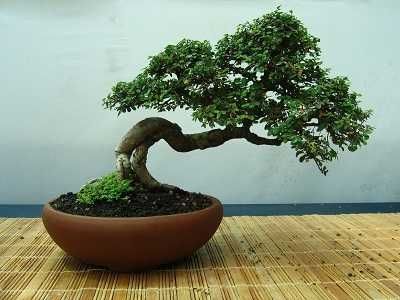One of the perplexing problems to the new member of a bonsai club is choosing the right pot for your tree. When they purchased the tree it was in a pot, and isn’t that good enough? Maybe it is not. When the tree is displayed it is part of a composition which includes the tree, the pot and the stand. Imagine being a lady invited to a fancy ball and you wear your beautiful Armani gown and your best jewelry and the tennis shoes that you used to work in the garden. That would be about the same effect as displaying a tree in a poorly chosen pot. So how do you pick the right pot?
A frequently quoted approach is to divide all trees into two groups, masculine and feminine. An example of a masculine tree is a stately pine tree, and a feminine tree example is a graceful maple tree. Many bonsai pots are either oval shaped or rectangular. The former is said to be feminine and the latter is masculine. So far so good. In theory all you have to do is to choose a masculine pot for a masculine tree and you are done. The problem with rigidly classifying all trees and pots into one of two groups is that there are many trees and pots that do not fit clearly into either group. A massive collected juniper with lots of craggy dead wood would appear to be a very masculine tree, but the beautiful flowing curved lines of the trunk and dead wood are features of the tree which seem to be feminine.

A way toward a choice of pot for your tree which bypasses a rigid classification into either masculine or feminine groups is to simply look at your tree. What is the most important feature of the tree that catches your eye? The pot you choose should echo this feature. Dave De Groot in his book, Basic Bonsai Design, offers a useful way of looking at what you might see in your tree and that is to consider a group of attributes, some or all of which your tree may have.
If the tree has a straight trunk and regular spacing of the branches, has a feeling of strength or drama or has the appearance of great age such as rough bark or deadwood, then the best choice of pot is a rectangular pot that has straight walls and plain feet and is of heavy construction. An unglazed pot would be best for this tree.
On the other hand, the tree may have an appearance of gentleness and grace, have gentle movement of the trunk line, have smooth bark or may appear to be young, indicated by lack of dead wood. Then the best pot is a rounded or oval form with curved walls and light color. Trees in flower or fruit also fall into this group. A glazed pot would work well. The construction of the pot should appear to be light with thin walls and small, curved feet.
Back to the collected juniper that didn’t seem to easily fit into either masculine or feminine classifications. The dominant features of many collected junipers are the curved trunk and the swirling flow of the exposed grain of the dead wood. An oval pot reflects this nicely in spite of the fact that you would be placing a tree with a lot of masculine characteristics in a feminine pot.
One of the things that make bonsai such an exciting activity is that it is as much art as it is science. This means that there are few clear, unambiguous answers, and this is particularly true when choosing the best pot for your tree. A great place to start is to simply look at your tree and decide what is the most important feature. Then find a pot which enhances or reflects this feature.

